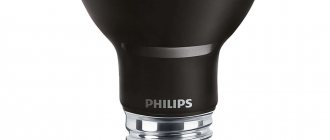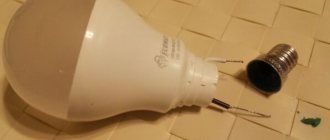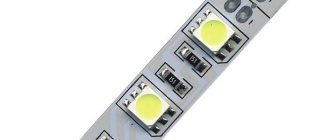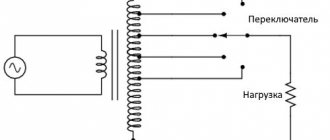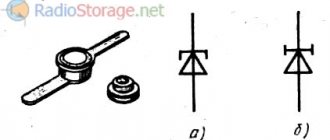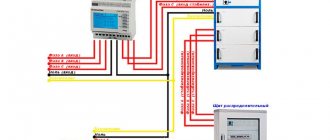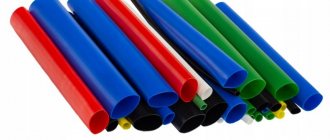What's happened
The basis of the design is a semiconductor crystal or chip, which is located on a special base and enclosed in a plastic case. At the bottom there are contacts that allow you to mount the LED on any surface. A lens mounted on top of the crystal is responsible for effective light scattering.
The semiconductor crystal is mounted on a massive base, which, together with wide contacts, effectively removes the heat generated during operation.
As a result of this arrangement, it became possible to install them directly on a printed circuit board.
Application and connection requirements
The scope of application of LED devices includes household, commercial and street lighting. Depending on the size of the SMD LEDs are placed in lamps or strip lighting. Several chips placed on the board replace standard incandescent and energy-saving fluorescent lamps. Devices with a wide angle of illumination are used in floodlights. LED matrices have replaced lamps in flashlights, headlights, signs, traffic lights and signs.
When connecting LEDs, polarity must be observed. For stable and long-term operation, a separate resistor is connected to each chain of series-connected LEDs. The power source must provide a voltage greater than the total value of all chips.
How to decipher the markings
An SMD LED is marked with a set of numbers and letters. The letters indicate whether the diode belongs to one type or another, the four numbers next to it indicate the size of the case, which is measured in millimeters. For example, SMD 5630 is decrypted as follows:
- SMD is a type of LED that involves surface application on a printed circuit board, i.e. without soldering into through holes;
- 5630 – case size equal to 5.6x3.0 mm.
Other technical characteristics can be found in the technical documentation supplied with the LED.
Where and how it is used
SMD LED is a good choice when light is needed and a larger fixture is not available. Ultra-bright diodes are mounted on circuit boards that are used in tiny devices such as wireless computer mice, remote controls, digital readout panels (such as on dishwashers or microwave ovens), digital clocks, or keyboard protection panels.
Compared to classic incandescent lamps, LED lamps are both capable of emitting white shades of light and can emit a multi-colored glow. This advantage allows them to be used as decorative elements, and not just as ordinary lamps for lighting.
Instead of drawing power from the electronic components and wasting it as heat (which would destroy any circuit board), when activated it wastes it as high-quality light. Super bright diodes are durable and last a very long time. Often the lamp itself stops functioning long before all the diodes fail.
Ultra-bright diodes are used as the main component for SMD tapes. Among the different types there are RGB strips. They can be adjusted using an RGB controller. In combination with Gauss LED lamps, SMD lamps will create beautiful and varied lighting.
Types of SMD
Depending on the size of the product, the number of semiconductors, the luminous flux and the number of crystals, SMD is divided into several types. Let's look at the main ones.
3528 - the most popular
The design of the SMD 3528 LED can use either one or three crystals simultaneously. In the case of a single semiconductor chip, the LED emits one color. The polycrystalline design gives the RGB effect, these are the so-called RGB LEDs.
To protect against external factors and improve color rendering, the upper part of the diode is coated with a transparent polymer resin.
Due to their compact dimensions, the ability to illuminate in the RGB range and low cost, they are widely used in lighting strips when creating interior elements for future housing, and in the production of inexpensive lamps and lanterns.
The main technical characteristics include:
- case dimensions – 3.5x2.8 mm;
- number of crystals – 1 or 3;
- power consumption – 0.06 or 0.2 W;
- luminous flux – 0.6 – 5 Lm;
- glow angle - 120⁰ - 140⁰.
By the way, these light-emitting diodes are used to assemble some of the most popular SMD 3528 LED strips in the world.
5050 - second most popular
The SMD 5050 LED is manufactured in three or four-chip versions. Improved color rendering is achieved by coating the diode with silicone, which contains a phosphor. In the case of parallel connection of crystals, it emits a fairly bright cool white light. When connected in series, it operates in the RGB and RGBW ranges.
High radiation power, the ability to change color temperature and work in the RGB and RGBW ranges allowed this type to be used not only as an element of decorative lighting, such as a ceiling, but also as the main light source.
The main technical characteristics include:
- case dimensions – 5.0x5.0 mm;
- number of crystals – 3 or 4;
- power consumption – 0.2 or 0.26 W;
- luminous flux – 2 – 14 Lm;
- glow angle - 120⁰ - 140⁰.
5630 - based on stabistors
The design of the SMD 5630 LED is based on the use of a single high-power semiconductor chip. It works exclusively in the white color range, with the ability to change the glow temperature.
Thanks to the crystal assembly on two stabistors and four wide contacts, effective heat dissipation is ensured. In addition, it is not afraid of changing the polarity of the connection.
Powerful luminous flux, built-in protection against voltage surges and effective heat dissipation have made it possible to use LEDs in powerful LED strips, lamps and outdoor lighting spotlights.
The main technical characteristics of the LED are:
- case dimensions – 5.6x3.0 mm;
- number of crystals – 1;
- power consumption – 0.5 W;
- luminous flux – 57 Lm;
- glow angle - 120⁰.
5730 - the best in brightness
LED SMD 5730 is available in single and double-chip versions. Can emit warm, neutral and cool white light. The surface of the crystal, for better color rendition, is coated with a polymer resin with a phosphor.
Equipped with four wide contacts. Only two are used for power supply, the rest are used for heat removal.
Double-crystal LEDs are capable of creating a luminous flux of 158 lm. Due to this, as well as good protection from moisture and dust, it is often used in floodlights and outdoor lighting fixtures, in rooms with a high content of moisture and dust in the air.
LED technical characteristics include:
- case dimensions – 5.7x3.0 mm;
- number of crystals – 1 or 2;
- power consumption – 0.5 or 1 W;
- luminous flux – 50 or 158 lm;
- glow angle - 120⁰.
3014 - good color rendering
Single-chip LED of moderate power. Depending on the version, it can emit white, red, blue or green.
Coating the crystal with a polymer resin with a phosphor made it possible to improve color rendition.
Compact dimensions, low energy consumption and a good level of protection from environmental influences have made it possible to use it as a lighting element in automobile lamps and spotlights.
The main technical characteristics of the LED are:
- case dimensions – 3.0x1.4 mm;
- number of crystals – 1;
- power consumption – 0.12 W;
- luminous flux – 9 or 11 lm;
- glow angle - 120⁰.
2835 - third most popular
Monocrystalline compact LED. Outwardly similar to SMD 3528, but differs from the latter by a rectangular lens made of translucent silicone with the addition of a phosphor. Depending on the version, it emits white light with different color temperatures.
High levels of luminous flux saturation and reliability combined with low cost made it possible to use it as a light source in lamps and spotlights for household and street lighting, as well as in LED strips.
Its main technical characteristics include:
- case dimensions – 2.8x3.5 mm;
- number of crystals – 1;
- power consumption – 0.5 or 1 W;
- luminous flux – 50 or 100 lm;
- glow angle - 120⁰.
We also recommend reading an interesting article about the SMD 2835 LED, in which we discussed in detail from the purpose and characteristics to the pros and cons.
0805 - compactness of its crown
Compact low power LED. One semiconductor crystal is used as a light source. Depending on the material of manufacture, it can emit white, blue, red, green and orange light.
The diode size is 0.8x0.5 mm. For ease of installation and better removal of heat generated during operation, it was installed on a 2.0x1.2 mm platform.
They have compact sizes, low power consumption and good luminous flux. They are used as indicators in household and industrial appliances, car dashboards, and also as light sources on information boards.
Main technical characteristics:
- case dimensions – 2.0x1.2 mm;
- number of crystals – 1;
- power consumption – 0.125 W;
- luminous flux – 0.35 Lm;
- glow angle - 120⁰.
1206 - another mini LED
To obtain the luminous flux, one small semiconductor crystal is used. The color it emits depends on the material it is made of. It has high-quality color rendering, which is achieved through the use of a polymer resin diffuser with the addition of a phosphor.
The dimensions of the light source are 1.2x0.6 mm, as indicated in the marking. But they do not allow the heat generated during operation to be quickly removed. In addition, difficulties arise when installing the diode. That is why it is installed on a more massive base, equal to 3.2x1.6 mm.
The LED is characterized by small dimensions, low power consumption, and high reliability. Due to this, it is used as an indicator in household appliances, industrial units and road signs.
Main technical characteristics:
- case dimensions – 3.2x1.6 mm;
- number of crystals – 1;
- power consumption – 0.25 W;
- luminous flux – 0.35 Lm;
- glow angle - 120⁰.
0603 - the smallest
The LED design is based on a low-power semiconductor crystal coated with a polymer resin containing a phosphor. Depending on the purpose and material of the crystal, it emits different colors.
According to the marking, the diode has dimensions of 0.6x0.3 mm. In practice they are slightly larger and amount to 1.6x0.8 mm. These dimensions are not a designation error. It's just that such a small diode is more difficult to produce and install. In addition, problems arise with heat dissipation. To eliminate all these shortcomings, the manufacturer mounts it on a more massive platform with a metallized base.
LED SMD 0603 is distinguished by its miniature size, resistance to shock and mechanical damage, as well as low power consumption. Because of this, they are used to illuminate buttons in phones and walkie-talkies, as well as when creating special interior elements in apartments.
The main technical characteristics include:
- case dimensions – 1.6x0.8 mm;
- number of crystals – 1;
- power consumption – 0.1 W;
- luminous flux – 0.35 Lm;
- glow angle - 120⁰.
4014 - ultra-thin
Compact front LED. A powerful semiconductor crystal is used as a light source, giving an even white glow. The use of a polymer resin with a phosphor made it possible to achieve a wide luminescence angle.
Thanks to innovative technologies, it has an ultra-thin design. Characterized by a bright, even glow. Due to these indicators, LEDs are often used to increase the brightness of matrix TVs and monitors, as well as as a light source in industrial lamps and reflectors.
The main technical characteristics are:
- case dimensions – 4.0x1.4 mm;
- number of crystals – 1;
- power consumption – 0.2 W;
- luminous flux – 120 Lm;
- glow angle - 120⁰.
1608 - economical energy consumption
The LED is made using monocrystalline technology. Various materials for its manufacture make it possible to obtain blue, red, yellow and green radiation. A wide viewing angle is achieved through the use of a rectangular silicone lens with the addition of a phosphor.
SMD 1608 is characterized by compact dimensions and low power consumption. They are used in LED strips for decorative lighting, illumination and indication of various types of devices.
The main characteristics include:
- case dimensions – 1.6x0.8 mm;
- number of crystals – 1;
- power consumption – 0.35 W;
- luminous flux – 0.25 Lm;
- glow angle - 120⁰.
3014 - the best light dispersion angle
Compact front LED. To create the light flux, a single medium-power semiconductor crystal is used.
Thanks to the use of a polymer resin with a phosphor as a lens, a wide angle of light dispersion and accurate color rendition are achieved.
The metal substrate located at the bottom of the case allows for efficient heat dissipation, extending trouble-free operation. The small size of the body and a fairly bright luminous flux made it possible to use it in various types of LED strips, household lamps, as well as in automobile lamps.
Technical characteristics of SMD 3014:
- case dimensions – 3.0x1.4 mm;
- number of crystals – 1;
- power consumption – 0.1 W;
- luminous flux – 11 Lm;
- glow angle - 120⁰.
7020 - the most crystals
Monocrystalline front-illuminated LED. The use of a high-power crystal, efficient heat dissipation and a polymer rectangular lens with a phosphor made it possible to achieve a bright and even white glow.
SMD 7020 appeared relatively recently on the domestic market, but has already established itself as a bright and reliable LED. It is used to illuminate shop windows, household premises, as well as bus interiors and luggage compartments of passenger cars.
The main characteristics of the SMD 7020 LED are:
- case dimensions – 7.0x2.0 mm;
- number of crystals – 1;
- power consumption – 0.5 W;
- luminous flux – 70 Lm;
- glow angle - 120⁰.
3020 - silicone coating
To create a luminous flux, the SMD 3020 LED uses a powerful single semiconductor crystal. It creates an even and comfortable white light flux. Protection from external factors is provided by polymer silicone, which also acts as a diverging lens.
The small size of the case, low power consumption, combined with a bright luminous flux, have made it possible to effectively use SMD to create household and industrial lamps and spotlights.
Technical characteristics of SMD 3020 LED:
- case dimensions – 3.0x2.0 mm;
- number of crystals – 1;
- power consumption – 0.06 W;
- luminous flux – 10 Lm;
- glow angle - 120⁰.
Explanation of LED markings
Consider the markings using the example of an SMD 3528 warm white light matrix.
LED-WW-SMD3528
- LED – light-emitting diode;
- WW – warm white – warm white;
- SMD – surface mount diode;
- 3528 – matrix dimensions.
Many manufacturers try to uniqueize their product with various tricks. This is how the 5636, 5736 series appear. Their characteristics are completely identical to the basic models, and the last number indicates only minor changes in the standard size.
Comparison table of reviewed LED SMDs
The summary table shows the characteristics of all the LEDs considered.
| No. | product name | Case dimensions, mm | Number of crystals, pcs | Power, W | Luminous flux, Lm | Luminescence angle, ⁰ |
| 1 | SMD 3528 | 3.5x2.8 | 1 or 3 | 0.06 or 0.2 | 0,6 – 5 | 120 or 140 |
| 2 | SMD 5050 | 5.0x5.0 | 3 or 4 | 0.2 or 0.26 | 2 – 14 | 120 or 140 |
| 3 | SMD 5630 | 5.6x3.0 | 1 | 0,5 | 57 | 120 |
| 4 | SMD 5730 | 5.7x3.0 | 1 or 2 | 0.5 or 1 | 50 – 158 | 120 |
| 5 | SMD 3014 | 3.0x1.4 | 1 | 0,12 | 9 -11 | 120 |
| 6 | SMD 2835 | 2.8x3.5 | 1 | 0.5 or 1 | 50 -100 | 120 |
| 7 | SMD 0805 | 2.0x1.2 | 1 | 0,125 | 0,35 | 120 |
| 8 | SMD 1206 | 3.2x1.6 | 1 | 0,25 | 0,35 | 120 |
| 9 | SMD 0603 | 1.6x0.8 | 1 | 0,1 | 0,35 | 120 |
| 10 | SMD 4014 | 40x1.4 | 1 | 0,2 | 120 | 120 |
| 11 | SMD 1608 | 1.6x0.8 | 1 | 0,25 | 0,35 | 120 |
| 12 | SMD 3014 | 3.0x1.4 | 1 | 0,1 | 11 | 120 |
| 13 | SMD 7020 | 7.0x2.0 | 1 | 0,5 | 70 | 120 |
| 14 | SMD 3020 | 3.0x2.0 | 1 | 0,06 | 10 | 120 |
What are the types?
In addition to the above, there are the following types of SMD LEDs.
Variety 5730-1
- These models have two separate crystals with a power of 1 W.
- Improved models have a high luminous flux of up to 158 lm/W.
- The maximum operating current is 350 A.
- Pulsating current – up to 800 A.
- Voltage 3.2 W.
- The electric-hole junction can withstand temperatures up to +130 degrees.
- The model is suitable for reflow soldering according to the JEDEC J-STD-020C standard.
Model 3014 is a relatively new example of ultra-bright diodes.
- The forward crystal current should not be higher than 30 mA.
- Forward voltage ranges from 3.0 to 3.6 V.
- White LEDs with warm shades of light have a minimum luminous efficiency of 8 lm.
- LEDs with cool shades have a maximum light output of 13 lm.
- The dimensions of SMD LEDs are 3.0x1.4x0.75 millimeters.
- The anode and cathode leads go to the bottom of the housing. This must be taken into account when producing the PCB.
- The size of the contact pads is increased, which significantly improves the heat sink function and the mounting of the diode itself.
Pros and cons of SMD over other types of LED
In addition to compactness and low power consumption, which all LEDs have, SMD has its own advantages. These include:
- possibility of mounting directly on a printed circuit board:
- excellent heat dissipation;
- instant ignition of the crystal;
- independence from the number of switches on and off;
- high level of color rendering;
- Possibility to select color temperature.
Despite all the advantages of SMD LEDs, there are also disadvantages, which include:
- high cost;
- low maintainability rates.
We also recommend reading an interesting article about the most popular types of LEDs.

